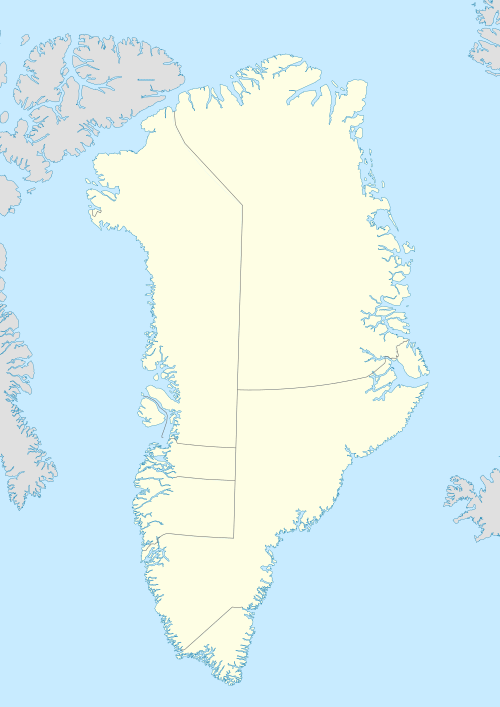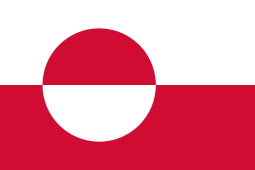Nipisat Island
Nipisat Island (Kalaallisut: "Lumpfish", referring to the island's shape)[1] is a small, uninhabited island in the Qeqqata municipality in central-western Greenland.
 Nipisat | |
| Geography | |
|---|---|
| Location | Davis Strait |
| Coordinates | 66°48′50″N 53°30′30″W |
| Area | 1.03 km2 (0.40 sq mi) |
| Administration | |
Greenland | |
| Municipality | Qeqqata |
| Official name | Aasivissuit – Nipisat. Inuit Hunting Ground between Ice and Sea |
| Type | Cultural |
| Criteria | (v) |
| Designated | 2018 |
| Reference no. | 1557 |
| State Party | |
| Region | Northern Europe |
Geography
Nipisat Island is situated 15 km (9.3 mi) south of Sisimiut, on the shores of Davis Strait. It belongs to the group of small islands and skerries located at the mouth of Ikertooq Fjord, immediately to the west of Sarfannguit Island.[2] Dwarf scrub heath, dwarf birch, Arctic willow, well-drained lichens, and herb vegetation dominate the flora.[3]
History
In the 18th century, the Danes and Norwegians came to Nipisat. In 1723, Hans Egede found native people actively engaged in hunting large whalebone whales in Nipisat and the Danes established the first settlement, a trading station here.[4] Two years later, a small mission was established on the island, but it was abandoned the following year, and then burnt down by Dutch whalers.[5] In 1727, the Norwegians Ditlev Vibe and Bishop Deichmann of Christiania recommended to the King of Denmark the re-establishment of a trade station at Nipisat and the establishment of a whaling station.[6] In 1728, Frederick I of Denmark ordered a fortress be constructed at Nipisat,[7] but two years later, he ordered its abandonment and evacuation.[8]
On 30 June 2018, it was inscribed as a UNESCO World Heritage site.[9]
Archaeology
The island is notable for its well preserved Saqqaq culture archaeological site, containing some stone artifacts that were previously unknown from the Saqqaq culture.[10] The Saqqaq people are not the ancestors of modern Kalaallit people, rather they are related to modern Chukchi and Koryak peoples.[11] The site, named after the island, was discovered in 1989 by Finn Kramer, curator of the Sisimiut Museum.[12] It lies approximately 50 m (160 ft) from the present coastline, situated on raised beaches with a southeastern slope. The area elevation ranges between 9 m (30 ft)and 13 m (43 ft) above mean sea level. This part of the island that contains the archaeological site, did not show signs of later occupation by Dorset culture or Thule culture.[12] However, it does show signs of pre-Dorset, and of Arctic small tool tradition.[13] During the five year evacuation period of 1989–1994, over 70,000 bone fragments and approximately 1,000 artifacts were recovered,[14] including 314 tools.[15]
References
- Gotfredsen, pp. 7
- Vandrekort Vestgrønland: Sisimiut (Map) (1996 ed.). Cartography by Compukort, Denmark. Greenland Tourism a/s.
- Gotfredsen, pp. 18
- Mirsky, Jeannette (1998). To the Arctic!: The Story of Northern Exploration from Earliest Times. University of Chicago Press. p. 218. ISBN 0-226-53179-1.
- Gotfredsen, pp. 12
- Heinzelmann, Eva; Robl, Stefanie; Riis, Thomas (2006). Der dänische Gesamtstaat: ein unterschätztes Weltreich?. verlag-ludwig. p. 149. ISBN 3-937719-01-6.
- Heinzelmann, pp. 153
- Heinzelmann, pp. 151
- Centre, UNESCO World Heritage. "Aasivissuit – Nipisat. Inuit Hunting Ground between Ice and Sea". whc.unesco.org. Retrieved 2018-07-03.
- Gotfredsen, Anne Birgitte; Mobjerg, Tinna (2004). Nipisat - a Saqqaq Culture Site in Sisimiut, Central West Greenland. Museum Tusculanum Press. p. 7. ISBN 87-635-1264-5.
- Walton, Doreen. "Analysis of hair DNA reveals ancient human's face." BBC News. (retrieved 11 February 2010)
- Gotfredsen, pp. 24
- Gotfredsen, pp. 11-12
- Gotfredsen, pp. 26
- Gotfredsen, pp. 43

